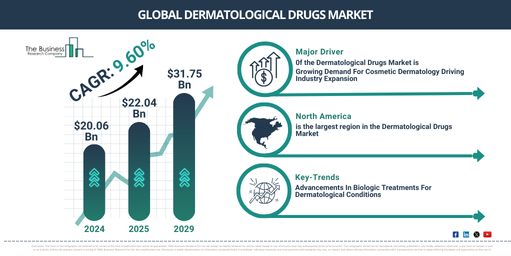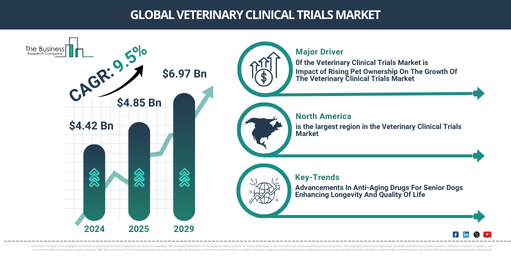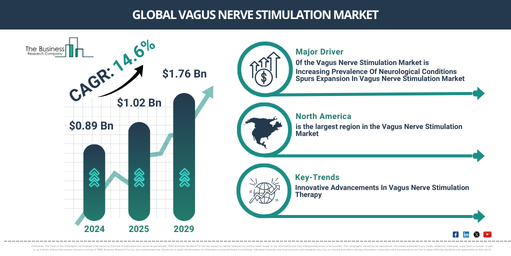Dermatological Drugs Market Growth Forecast: Exploring Trends and Opportunities for the Next Decade
Updated 2025 Market Reports Released: Trends, Forecasts to 2034 – Early Purchase Your Competitive Edge Today!
What Growth Opportunities are Expected to Drive the Dermatological Drugs Market’s CAGR Through 2034?
The market size for dermatological drugs has seen robust expansion in the recent past. This market is projected to swell from $20.06 billion in 2024 to $22.04 billion in 2025, exhibiting a compound annual growth rate (CAGR) of 9.8%. The historical growth is primarily driven by increasing incidences of skin ailments, advancements in medication formulation and delivery systems, rising consciousness about skin health and aesthetics, an expanding older population, and escalating demand for over-the-counter skincare products.
Anticipated robust growth is on the horizon for the dermatological drugs market in the upcoming years, as it is projected to expand to $31.75 billion in 2029 with a 9.6% compound annual growth rate (CAGR). Factors contributing to this projected growth in the forecast period includes advancements in biologics and targeted therapies, the rising adoption of teledermatology and digital health, an increased prevalence of skin conditions tied to lifestyle habits, an uptick in the demand for personalized and regenerative medicine, and heightened research in microbiome-based skin treatments. Key trends for the forecast period include dermatological drug delivery via nanotechnology, AI-enhanced dermatological diagnostics, microbiome-focused therapies, skin regeneration through 3D bioprinting, and treatments using gene editing and RNA.
What Industry-Specific Factors Are Fueling the Growth of the Dermatological Drugs Market?
The surge in demand for procedures related to cosmetic dermatology is anticipated to accelerate the expansion of the dermatological drugs market. Cosmetic dermatology is a particular subset of dermatology that aims at enhancing an individual’s looks through several non-invasive treatments and procedures. The demand for this branch of dermatology is escalating due to heightened consumer understanding of aesthetic treatments, advancements made in skincare technology, and an increasing inclination toward non-invasive procedures to improve looks and tackle aging. The escalating demand for cosmetic dermatology procedures, such as treatments geared toward rejuvenation of the skin and combating aging, is propelling the creation of superior dermatological drugs that deliver safe, effective and minimally invasive outcomes. For example, in January 2023, as per data from the International Society of Aesthetic Plastic Surgery, a US-based professional body, over 12.8 million surgical and 17.5 million non-surgical procedures were undertaken worldwide, representing a surge of 19.3% in total procedures compared to the previous reporting period. Furthermore, more than 14.9 million surgical and 18.8 million non-surgical procedures are expected to be performed worldwide by plastic surgeons in 2022, marking an 11.2% increase in total procedures executed. Consequently, the upsurge in cosmetic dermatology procedures is fostering the growth of the dermatological drugs market.
Get Your Free Sample of the Global Dermatological Drugs Market Report Now!
https://www.thebusinessresearchcompany.com/sample.aspx?id=21166&type=smp
What Are the Leading Industry Players Dominating the Dermatological Drugs Market?
Major companies operating in the dermatological drugs market are Pfizer Inc., Johnson & Johnson Services Inc., AbbVie Inc., Bayer AG, AstraZeneca plc, Novartis AG, GlaxoSmithKline Plc, Eli Lilly and Company, Amgen Inc., Bausch Health Companies Inc., Organon International, Galderma, Incyte Corporation, Glenmark Pharmaceuticals Ltd., Mayne Pharma Group Limited, Dermavant Sciences Inc., Taro Pharmaceutical Industries Ltd., Biofrontera AG, Almirall SA, UCB SA, LEO Pharma A/S, Dermira Inc.
What Are the Latest Trends Leading to Disruption in the Dermatological Drugs Market?
Established organizations in the dermatological drugs market are focusing on the creation of biologic therapies to treat chronic skin ailments such as psoriasis, atopic dermatitis, and hidradenitis suppurativa. Biologics, by addressing specific immune pathways, offer a more potent and enduring solution than conventional treatments. For example, in September 2024, US pharmaceutical firm Eli Lilly and Company gained approval for Ebglyss (lebrikizumab), a focussed interleukin-13 (IL-13) inhibitor, to treat moderate-to-severe atopic dermatitis in adults and children aged 12 years and above. This authorization signifies a crucial progression by introducing a new biologic treatment option for patients who haven’t found satisfactory symptom control with topical therapies. With the goal of providing more efficient solutions, Ebglyss aims to enhance patients’ quality of life by alleviating severe itching and skin inflammation associated with moderate-to-severe atopic dermatitis.
Get Instant Access to the Global Dermatological Drugs Market Report with Swift Delivery!
https://www.thebusinessresearchcompany.com/report/dermatological-drugs-global-market-report
What Are the Strategic Segments Comprising the Dermatological Drugs Market and Their Growth Contributions?
The dermatological drugs market covered in this report is segmented –
1) By Drug Class: Corticosteroids, Retinoids, Antibiotics, Antifungals, Calcineurin Inhibitors, Other Drug Classes
2) By Administration: Topical Administration, Oral Administration, Parenteral Administration
3) By Indication: Acne, Psoriasis, Rosacea, Alopecia, Other Indications
4) By Distribution Channel: Hospital Pharmacies, Retail Pharmacies, Other Distribution Channels
Subsegments:
1) By Corticosteroids: Topical Corticosteroids, Oral Corticosteroids, Injectable Corticosteroids
2) By Retinoids: Topical Retinoids, Oral Retinoids
3) By Antibiotics: Topical Antibiotics, Oral Antibiotics
4) By Antifungals: Topical Antifungals, Oral Antifungals
5) By Calcineurin Inhibitors: Topical Calcineurin Inhibitors, Systemic Calcineurin Inhibitors
6) By Other Drug Classes: Biologics, JAK Inhibitors, Antihistamines, Photodynamic Therapy Agents
Which Regions Are Significant to the Growth of the Dermatological Drugs Market?
North America was the largest region in the dermatological drugs market in 2024. Asia-Pacific is expected to be the fastest-growing region in the forecast period. The regions covered in the dermatological drugs market report are Asia-Pacific, Western Europe, Eastern Europe, North America, South America, Middle East, Africa.
How Can We Define the Dermatological Drugs Market and Its Key Components?
Dermatological drugs refer to medications designed to treat conditions affecting the skin, hair, and nails by reducing inflammation, controlling infections, or managing symptoms such as itching and redness. These drugs play a crucial role in dermatology by addressing both common and severe skin disorders, improving patient comfort and quality of life.
Browse Through More Similar Reports By The Business Research Company:
Systemic Lupus Erythematosus Treatment Global Market Report 2025
Hematopoietic Stem Cell Transplantation Global Market Report 2025
Negative Pressure Wound Therapy Global Market Report 2025
https://thebusinessresearchcompany.com/report/negative-pressure-wound-therapy-global-market-report
About The Business Research Company:
With over 15000+ reports from 27 industries covering 60+ geographies, The Business Research Company has built a reputation for offering comprehensive, data-rich research and insights. Armed with 1,500,000 datasets, the optimistic contribution of in-depth secondary research, and unique insights from industry leaders, you can get the information you need to stay ahead in the game.
Contact us at:
The Business Research Company: https://www.thebusinessresearchcompany.com/
Americas +1 3156230293
Asia +44 2071930708
Europe +44 2071930708
Email us at info@tbrc.info
Follow us on:
LinkedIn: https://in.linkedin.com/company/the-business-research-company
YouTube: https://www.youtube.com/channel/UC24_fI0rV8cR5DxlCpgmyFQ
Global Market Model: https://www.thebusinessresearchcompany.com/global-market-model
Found this article helpful? Share it on:



